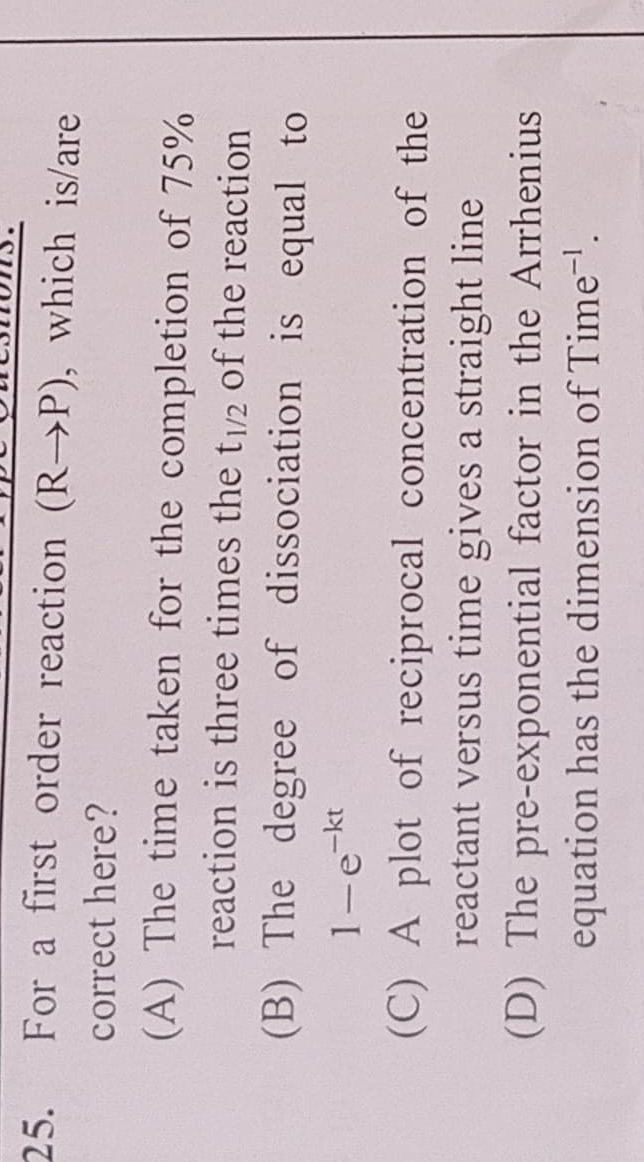Question
Question: For a first order reaction (R→P), which is/are correct here?...
For a first order reaction (R→P), which is/are correct here?

The time taken for the completion of 75% reaction is three times the t1/2 of the reaction
The degree of dissociation is equal to 1-e−kt
A plot of reciprocal concentration of the reactant versus time gives a straight line
The pre-exponential factor in the Arrhenius equation has the dimension of Time−1.
(B) and (D)
Solution
1. Analysis of Option (A):
For a first-order reaction, the integrated rate law is given by: k=t1ln[R][R]0
The half-life (t1/2) is the time taken for the concentration of the reactant to reduce to half its initial value, i.e., [R]=[R]0/2. t1/2=k1ln[R]0/2[R]0=k1ln2
The time taken for 75% completion (t75%) means that 75% of the reactant has reacted, so the remaining concentration is [R]=[R]0−0.75[R]0=0.25[R]0=[R]0/4. t75%=k1ln[R]0/4[R]0=k1ln4
Since ln4=ln(22)=2ln2, t75%=k2ln2
Comparing t75% and t1/2: t75%=2×(kln2)=2×t1/2
So, the time taken for 75% completion is twice the half-life, not three times. Therefore, option (A) is incorrect.
2. Analysis of Option (B):
The degree of dissociation (α) is the fraction of the reactant that has reacted. α=initial amountamount reacted=[R]0[R]0−[R]=1−[R]0[R]
From the integrated rate law for a first-order reaction, we have: kt=ln[R][R]0 Taking the exponential of both sides: ekt=[R][R]0 Rearranging, we get: [R]0[R]=e−kt
Substitute this expression into the equation for α: α=1−e−kt Therefore, option (B) is correct.
3. Analysis of Option (C):
For a first-order reaction, the integrated rate law is ln[R]=−kt+ln[R]0. A plot of ln[R] versus time (t) yields a straight line with a slope of −k and an intercept of ln[R]0.
A plot of reciprocal concentration of the reactant (1/[R]) versus time (t) gives a straight line for a second-order reaction, where the integrated rate law is [R]1=kt+[R]01. Therefore, option (C) is incorrect for a first-order reaction.
4. Analysis of Option (D):
The Arrhenius equation relates the rate constant (k) to temperature: k=Ae−Ea/RT
Here, A is the pre-exponential factor (or frequency factor), Ea is the activation energy, R is the gas constant, and T is the absolute temperature.
The exponent term, −Ea/RT, is dimensionless. This means that the dimensions of the rate constant (k) must be the same as the dimensions of the pre-exponential factor (A).
For a first-order reaction, the rate law is: Rate =k[R]
The units of Rate are typically Concentration/Time (e.g., mol L−1 s−1). The units of Concentration ([R]) are Concentration (e.g., mol L−1).
To find the units of k: Units of k=Units of [R]Units of Rate=ConcentrationConcentration/Time=Time−1 (e.g., s−1, min−1).
Since the dimension of k for a first-order reaction is Time−1, the dimension of the pre-exponential factor A must also be Time−1. Therefore, option (D) is correct.
Conclusion:
Both options (B) and (D) are correct.
